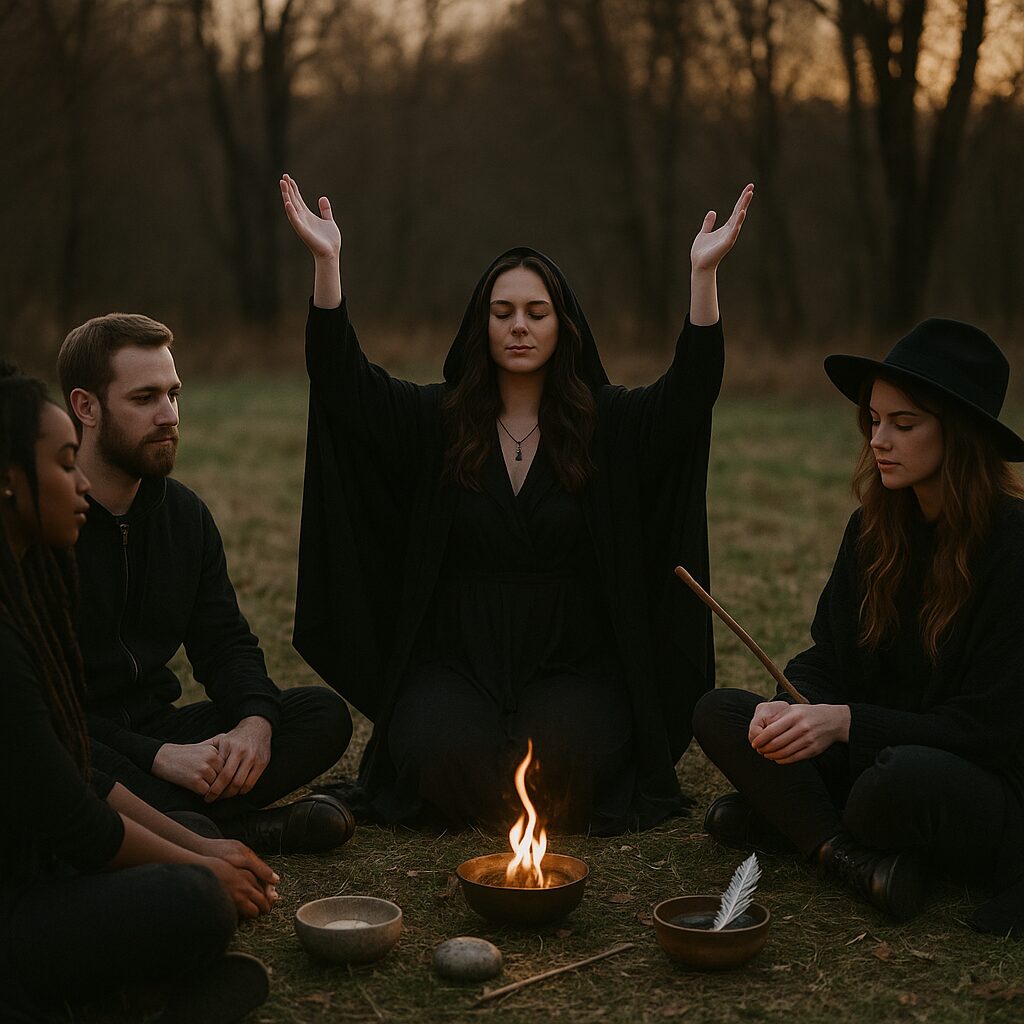Elemental Magic
Elemental Magic is the art of working with the four fundamental forces of nature—Earth, Air, Fire, and Water—as both literal presences and archetypal currents. To engage with them is to align oneself with the oldest and most enduring framework of the Craft. The elements are not simply building blocks of matter but living powers, each carrying its own qualities, gifts, and dangers. To practice elemental magic is to call, honor, and channel these forces—sometimes singly, sometimes in balance—to shape the energy of a working and to align the practitioner with the rhythm of the natural world.
Each element holds duality: its blessings and its challenges, its gifts and its warnings.
- Earth is the force of stability, grounding, and material manifestation. It roots, nourishes, and shelters. Yet earth can also stagnate, trapping energy in heaviness or resistance.
- Air governs clarity, inspiration, and communication. It moves swiftly, carries messages, and opens the mind. Yet air can also scatter focus and dissipate will if not directed.
- Fire embodies transformation, passion, and courage. It ignites change, brings light, and fuels boldness. Yet fire can also consume recklessly, leaving ash where once there was promise.
- Water flows with healing, intuition, and emotional depth. It soothes, cleanses, and binds together. Yet water can also overwhelm, drowning clarity in tides of feeling or illusion.
In ritual practice, these powers are not abstract but experiential. Earth is felt in stone, soil, and bone; Air in wind, breath, and song; Fire in flame, sun, and blood; Water in rivers, tears, and tides. To work with them is to cultivate both respect and relationship, recognizing that each is alive and cannot be commanded without consequence.
Within the Coven of the Veiled Moon, elemental magic is woven into nearly all of our workings. In circle casting, we call upon the four directions—North for Earth, East for Air, South for Fire, and West for Water—inviting their guardianship and balance. Our seasonal rites honor their cyclical interplay: Fire at midsummer, Water at harvest, Air at the equinoxes, Earth at midwinter. Some members cultivate deep partnerships with a single element, dedicating themselves to its mysteries, while others move fluidly among them, calling what is most needed for the spell at hand.
Elemental correspondences shape much of our spellcraft: charging a talisman in running water for purification, burning herbs to release a prayer into the air, or burying an offering in the earth to seed manifestation. At times, the coven works in elemental focus—crafting a rite of Fire to burn away old obstacles, or of Water to mend rifts in spirit. At other times, we invoke all four in careful balance, weaving a circle of harmony and strength.
Elemental magic resonates deeply with many other branches of the Craft. In alchemy, the elements provide the symbolic framework for transformation—the furnace of Fire, the distillation of Air, the dissolving of Water, and the crystallization of Earth. In dream magic, the elements appear in archetypal forms: floods, storms, wildfires, caverns, all carrying lessons and warnings. In divination, elemental correspondences guide interpretation—swords of Air, wands of Fire, cups of Water, pentacles of Earth. In healing magic, earth-born herbs, fiery oils, cleansing waters, and breathwork all draw directly upon elemental forces. And in protection magic, elemental wards are among the strongest defenses: earth circles that hold firm, fires that repel, winds that scatter, waters that wash clean.
Through these interconnections, elemental magic becomes more than a single practice—it is the foundation upon which much of the Craft rests.
Elemental magic begins simply, with gestures of acknowledgment: lighting a candle for Fire, placing a stone for Earth, breathing deeply for Air, pouring water for Water. With time, the practitioner learns to balance these forces, invoking them in harmony rather than discord. At deeper levels, elemental magic becomes relational: the practitioner builds alliances with elemental spirits or beings, learning their lessons and honoring their presence. At its highest level, the elements are experienced not as external forces but as mirrors of the self—body as Earth, breath as Air, spirit as Fire, blood as Water. In this way, the path of elemental magic is also a path of self-knowledge.
Examples
- Calling the four directions and their elemental guardians during circle casting to establish sacred space.
- Charging a talisman in running water to cleanse and attune it to flow.
- Burning herbs tied to a spell’s purpose, releasing intent into the air as smoke.
- Burying an offering in the soil to ground and manifest the working.
Note: The elements are the oldest allies of magic, but they are never passive tools. To draw upon them is to invite the raw currents of nature itself—stable yet volatile, nurturing yet dangerous. Misuse can unbalance not only the spell but the practitioner. Excessive fire consumes; unchecked water floods; stagnant earth suffocates; restless air disperses.
For this reason, elemental magic requires both respect and balance. Protections must be set, intentions kept clear, and energies grounded at the close. In the Coven of the Veiled Moon, we treat the elements as living forces and teachers, never as symbols to be bent to our will. When approached with reverence, they lend their immense power to our workings. When treated carelessly, they can unsettle, overwhelm, or even undo the very intentions they were called to serve.

